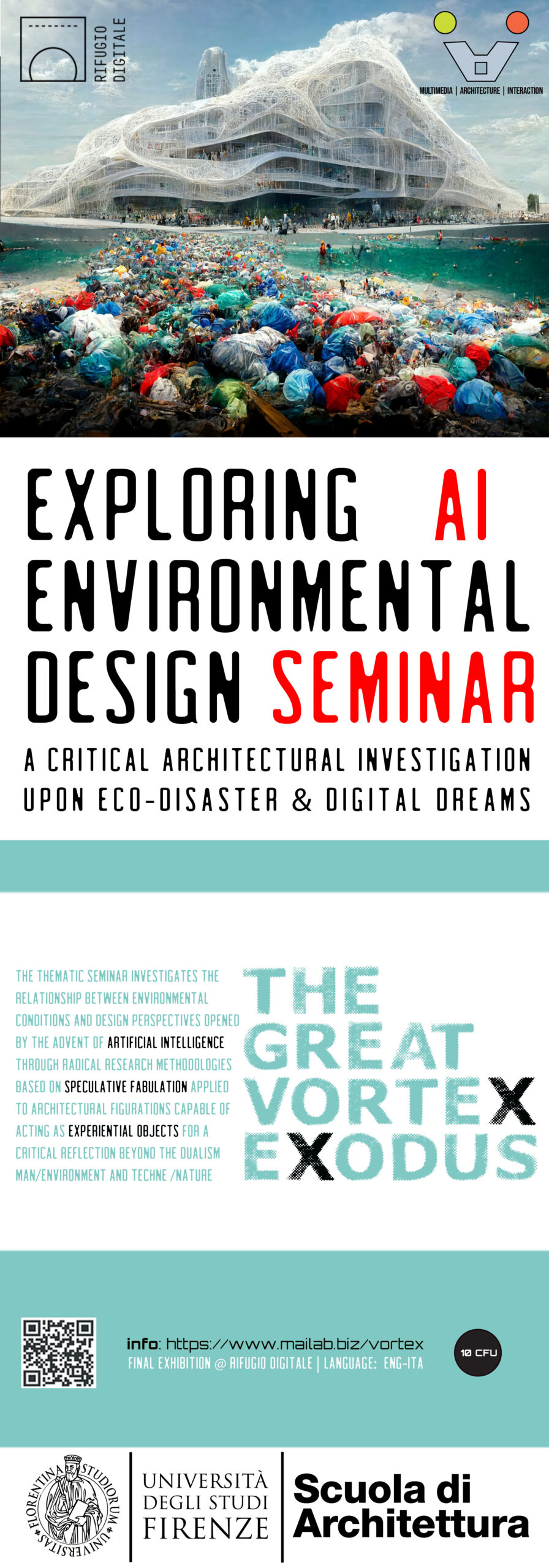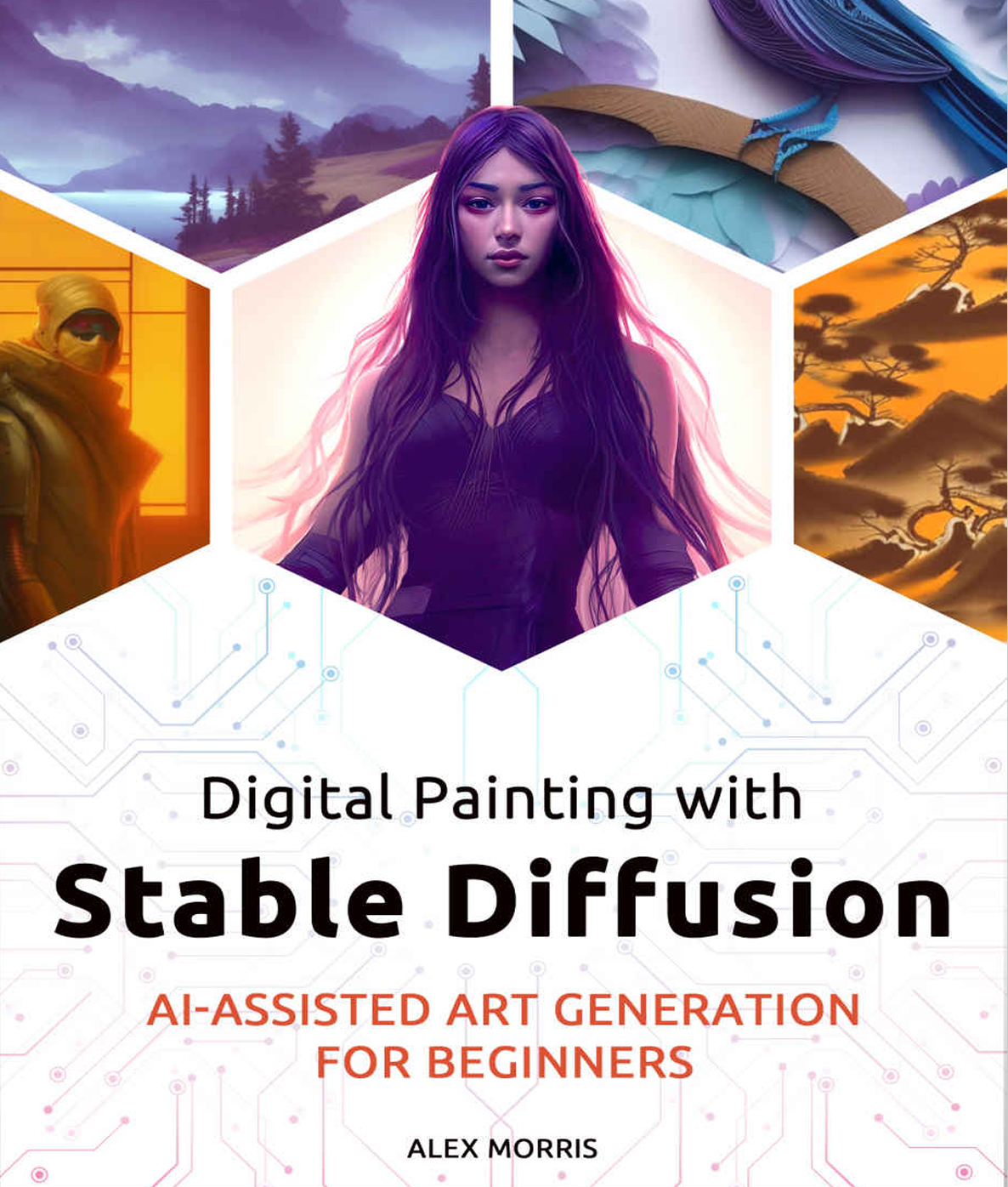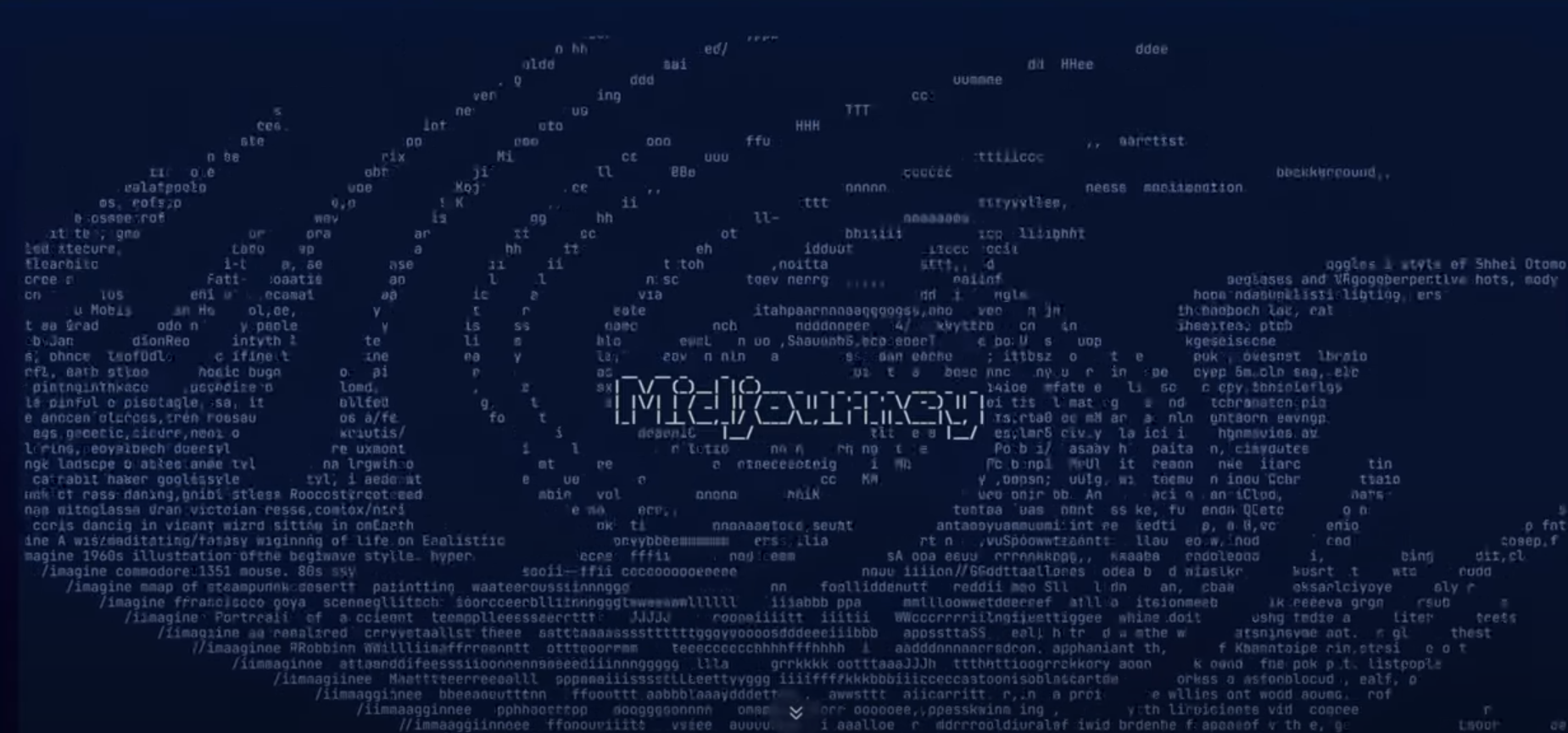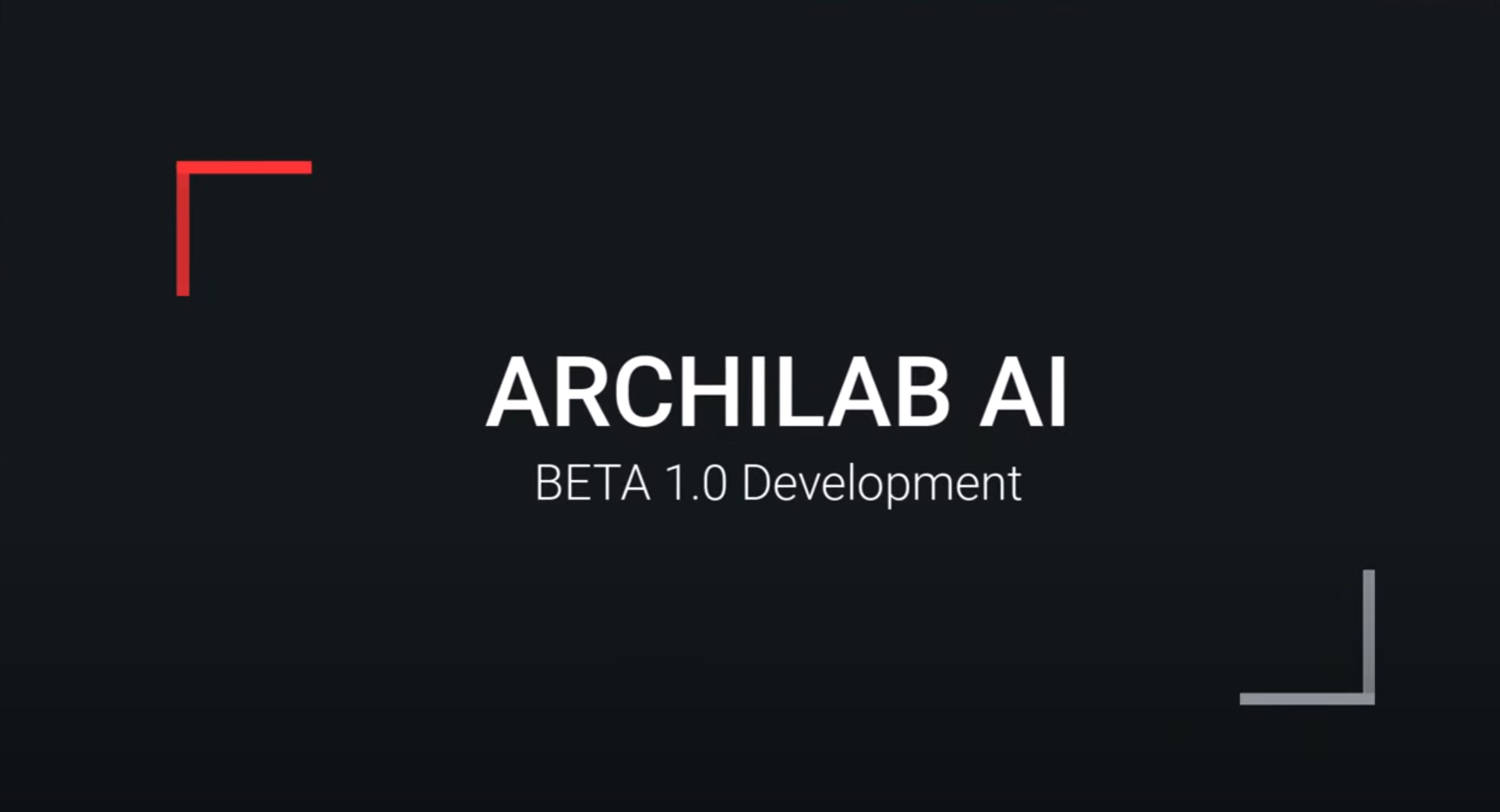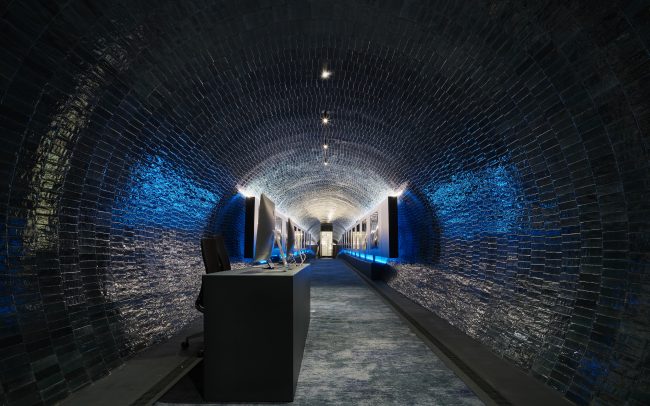Bibliografia
Agamben G. 2008, Che cos’è il contemporaneo?, Nottetempo, Roma. Baumgarten A. G., 2002, Estetica, Aesthetica, Palermo (orig. ed. 1750).
Auge M. 2007, Un mondo mobile e illeggibile, in Augé M., Tra i confini, Bruno Mondadori, Milano.
Austin J., 2017, Senso e sensibilia, Casa Editrice Marietti, 2017, Bologna (orig. ed. 1962).
Badiou A. 2011, Il concetto di modello. Introduzione ad una epistemologia materialista della matematica, Asterios Editore, Trieste, (orig. ed. 1969).
Barad K. 2007, Meeting the Universe Halfway.Quantum Physics and the Entanglement of Matter and Meaning,Duke University Press, Durham & London.
Baumgarten, A. G., 2002, Estetica, Aesthetica, Palermo (orig. ed. 1750).
Berger A. 2006, ‘Drosscape’, in Waldheim C. (editor), The Landscape Urbanism Reader, Princeton Univ. Press, pgg. 197-217.
Bernestein P. 2022, Machine Learning Architecture in the Age of Artificial Intelligence, Riba, London
Brady E. 2013, The Sublime in the Modern Philosophy. Aesthetics, Etichs, and Nature, Cambridge University Press, Cambridge.
Burke E. 1990, A Philosophical Enquiry into the Origin of our Ideas of the Sublime and Beauty, , Oxford University Press, Oxford (1st ed. 1757).
Burtynsky E., Baichwal J., De Pencier N., 2019, Anthropocene, Art Gallery of Ontario, Toronto.
Calvino I. 1974, Le città invisibili, Giulio Einaudi, Torino.
Chaillou . (2019), AI+Arhitecture. Towards a New Appoach, Harvard, Cambridge Massachusetts
Clark R. H., Pause M. 1996, Precedents in Architecture. Analytic Diagrams, Formative Ideas, and Parts, John Wiley & Sons.Inc, 2012 Hoboken, New Jersey. (1st ed.1985).
Dardot P. 2016, Senso comune e senso «del» comune. Le pratiche istituenti dell’Aisthetesis. <https://operavivamagazine org/senso-comune-e-senso-del-comune/>.
Dehaene M., De Cauter L. 2008, Heterotopia and the City. Public Space in a postcivil society, Routledge, Oxon-NYC.
de Solà-Morales I. 1995, ‘Terrain Vague’, in Davidson, C. (editor), Anyplace, MIT Press, Cambridge, pp. 118-123.
Eisenmann P. 2010, ‘Diagram. An original Scene of Writing’. in Garcia M., (editor) The Diagrams of Architecture, John Wiley & Sns Ltd, Chichester, West Sussex, pp. 92-103.
Fargione D. 2016, Oltre l’antropocentrismo. Il sublime ecologico nel contesto anglo-americano <https://iris.unito.it/retrieve/handle/2318/1556908/161501/FARGIONE.Sublime.pdf>.
Finn E. 2018, Cosa vogliono gli algoritmi. L’immaginazione nell’era dei computer, Giulio Einaudi Editore, Torino (orig. ed. 2017)
Foucault M.2016, Le parole e le cose, Rizzoli, Milano, (orig. ed. 1966).
Foucault M. 2011, Spazi Altri, Mimesis Edizioni, Milano (orig.ed. 1967).
Frazer, J. 1995, An Evolutionary Architecture, Architectural Association Press, London.
Garcia M. 2010, ‘Introduction: History and Theory of the Diagrams of Architecture’, in Garcia M., (editor) The Diagrams of Architecture, John Wiley & Sns Ltd, Chichester, West Sussex, pp. 18-45.
Gero, J.S. 1990, ‘Design Prototypes: A Knowledge Representation Schema for Design’,in AI Magazine 11 (4), pp. 26-36.
Guala F. 2002, ‘Models-Based Reasoning’, in Magnani L., Nersessian N.J.(editors), Model-Based Reasoning, Springer , Cham, pp.59-74.
Harman G. 2017, Object Oriented Ontology: A New Theory of Everything, Pelican Books, London.
Hartmann S. 1996, ‘The world as a process: simulations in the natural and social sciences’, in R. Hegselmann, U. Mueller, and K. Troitzsch (editors), Modelling and Simulation in the Social Sciences from the Philosophy of Science Point of View, Kluwer, Dordrecht, pp.77-100.
Heidegger M. 1971, ‘Building Dwelling Thinking’ in Heidegger M. Poetry, Language, Thought, Harper Colophon Books, New York, (ed. orig. 1957). < http://faculty.arch.utah.edu/miller/4270heidegger.pdf>
Hitt C. 1999, ‘Toward an Ecological Sublime’. In New Literary History 30/3: 603-23 <http://www.jstor.org/stable/20057557>
Heterington K. 1997, The Badlands of Modernity: Heterotopia and Social Ordering, Routledge, London.
Johnston,W. A. 2005, ‘Third Nature: The co-Evolution of Human Behaviour, Culture, and Technology’, in Non linear Dynamics, Psychology, and Life Science, vol. 9 n°3, July, 2005, Society for Chaos Theory in Psychology &Life Sciences, pp. 235-280.
Kaplan, J.2018 Intelligenza artificiale. Guida al futuro prossimo, Luiss University Press, Roma (1st ed. 2017)
Kipling R. J. 2015, ‘The bridge-builders’ in Kipling R. J., Stories and Poems, OUP, Oxford (1st ed. 1893).
Koohlaas R. 2006, Junkspace, Quolibet, Macerata (orig.ed. 1995).
Lana S., 2016, Ipotesi per una comunità estetica. Di alcuni motivi dentro e oltre la Critica del Giudizio di Kant. <http://www.eticapubblica.it/wp-content/uploads/2016/11/1_2016_Lana.pdf>
Latour B. 1993, We Have Never Been Modern, Harvard University Press, Cambridge.
Latour B. 2017, Il culto moderno dei fattici, Meltemi editore, Milano (orig. ed. 1996).
Latour B. 2017, Facing Gaia. Eight Lectures on the New Climatic Regime, Polity Press, Cambridge (orig. ed. 2015).
Leach N. 2022, Architecture in the Age of Artificial Intelligence. An Introduction to AI for Architects, Bllomsbury, London-New York
Lovelock, J. 2000, Gaia – A new look at the life on Earth, Oxford University Press, Oxford (1st ed. 1979).
Lyotard J. F. 1994, Lessons on the Analytic of the Sublime, Stanford University Press, Stanford (CA) (orig. ed. 1991).
Lyotard, J. F. 1995, Anima Minima. Sul bello e il sublime, Pratiche Editrice (1st ed. 2011).
Meadows, D. et alii (1972), The Limits to Growth, Universe Book, New York.
Montani P. 2010, L’immaginazione intermediale. Perlustrare, rifigurare, testimoniare il mondo visibile, Edizioni Laterza,Bari.
Morton T. 2016, Dark ecology: for a logic of future coexistence, Columbia University Press, New York.
Morton T. 2018, Being Ecological, Pelican Random House, London.
Morton T. 2019, Come un’ombra dal futuro, Aboca, Sansepolcro. (ed. orig. 2010)
Muir R. 1999, Approaches to Landscape, Mac Millian Press Ltd, London.
Naabarro, R., Richards, D., Chapman, H. 1980, ‘Foreword’, in Wasteland: A Thames Television Report, London, Thames Television, London.
Naess, A. (1989), Ecology, community and lifestyle, Cambridge University Press, Cambridge. (ed. orig. 1976).
Olwig, K. 2002, Landscape, Nature and the Body Politic, University of Wisconsin Press, Madison
Oppenlaender, J. 2022, The Creativity of Text-to-Image Generation <https://arxiv.org/abs/2206.02904>
Patriarca S. 2018, Il digitale quotidiano. Così si traforma l’essere umano, Castelvecchi,Roma
Ridolfi G. 2018, ‘Rethorical figures of an Alpine hut’. in Kane R. , A landscape of contradiction, Didapress, Firenze.
Ridolfi G. 2019 , ‘La condizione contemporanea del progetto. Rapporto sul Matema Digitale’, in Mussinelli E., Lauria M., Tucci F.(editors) , La PROduzione del PROgetto, Maggioli Editore, Santarcangelo di Romagna
Ridolfi G, Traumnovelle 2019, Isolation and Reconnection. Ten Bridges at La Maddalena, Didapress, Firenze.
Ridolfi G. 2022, ‘Landscape and ecological practice when the flood has drowned everything’, in: Gensini V.. Progetto RIVA. Suoni, immagini Racconti sul fiume, pp. 44-51, Cinesello Balsamo: Silvana Editoriale.
Serres M. 1995, The Natural Contract, , The University of Michigan Press, Ann Arbors (orig. ed. 1992).
Severino E.1992, Oltre il linguaggio, Adelphi, Milano
Soja E. 1989, Postmodern Geographies: the reassertion of space in critical social theory, Verso, London.
Sonvilla-Weiss S. 2008, (IN)VISIBLE Learning to Act in the Metaverse, Springer, Wien-New York
Steiner F.2008, The Living Landscape, Island Press, Washington (1st ed. 2000).
Tsing A. L.2015, The Mushroom at the End of the World. On the Possibility of Life in Capitalism Ruins,.Princeton University Press, Princeton & Oxford.
Vaihinger H. 1935, The Philosophy of ‘As if’. A System of the Theoretical, Practical and Religious Fictions of Mankind, Harcourt, Brace &Company, New York. (1 ed. 1911).
Wallis B et alii 2006, Ecotopia: The Second ICP Triennal of Photography and Video, Steidl, Gottinga.
Wisenberg E.B. 2010, Science in the Age of Computer Simulation, University of Chicago Press, Chicago-London
Wylie J. 2007, Landscape, Routledge, London & New York.
Zuboff, S.(2019), Il capitalismo della sorveglianza. Il futuro dell’umanità nell’era dei nuovi poteri digitali, Luiss University Press, Roma (orig. ed. 2019)


